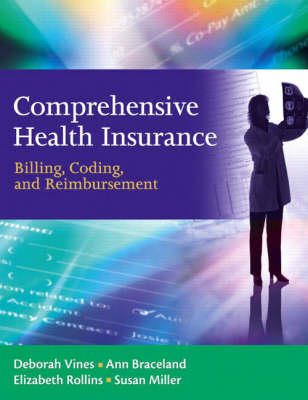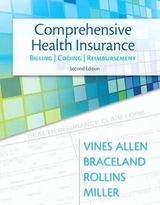
Comprehensive Health Insurance
Pearson (Verlag)
978-0-13-236815-5 (ISBN)
- Titel erscheint in neuer Auflage
- Artikel merken
Deborah Vines has worked extensively for over 20 years in the healthcare industry as a Practice Administrator and Manager in physical therapy, dermatopathology and pediatrics. She has also held management positions in the hospital setting. As Director of Operations for a national healthcare staffing corporation, she has traveled across the United States, working directly with physicians and medical human resources to secure jobs for individuals in the medical billing, coding and collection fields. A mentionable achievement of Ms. Vines’ is in one fiscal year she assisted 300 recruits find employment in this industry through mentoring and training. This achievement led her to open a successful vocational school specializing in medical office specialist training. Ann B. Braceland has been working in the medical field since graduation from Gwynedd Mercy College is 1964 with an associate's degree in nursing. As a practice manager she has demonstrated the ability to adopt to changes to the challenges that arise in medical billing, coding and managed care contracts. Mrs. Braceland has established and managed offices in Physical Medicine and Occupational Medicine. These experiences led her to teaching skills. She is now highly regarded for training physicians and medical personnel in compliance coding, billing as well as medical office management. She was a Medicare representative and Director of Training of Allied Career School in Dallas, TX. Her teaching and lectures has formed the basis of this subsequent text. Elizabeth Rollins, NCICS began her career in a nationally renowned multi-office pediatric ophthalmology practice. She worked in every position, from medical receptionist and appointment scheduling, to medical records and insurance claims submission, before being promoted to Insurance/Collection Manager. She completed insurance claims by hand and typed the patient billing statements for four years until the practice became computerized. As a Certified Account Manager for a national healthcare staffing corporation, Elizabeth met with hospitals, physicians, clinics and CBOs to assess their employment needs and showcase her roster of employees ready for hire. Elizabeth is a National Certified Insurance and Coding Specialist as well as the Director and an Instructor at a vocational school where she enjoys meeting with, teaching and encouraging students on a daily basis. Susan Miller, NCICS has 20 years experience in the medical field and currently specializes in dialysis billing. She was previously a Lead Instructor at a vocational school, preparing students for a career in the medical field as medical office specialists. She has acted as a supervisor at insurance companies and worked one-on-one with policyholders to assist them in having a better understanding of health insurance. In 2004 she obtained the title of National Certified Insurance & Coding Specialist. She also holds certificates from Career Colleges and schools of Texas and Brookhaven College for Interactive Leadership Skills for Educators.
Preface
Section I — A Career in Healthcare
CHAPTER 1: INTRODUCTION TO PROFESSIONAL BILLING AND CODING CAREERS
Employment Demand
Facilities
Physician Practice
Hospital
Centralized Billing Office
Job Descriptions
Medical Office Assistant
Medical Biller
Medical Coder
Registered Health Information Technicians (RHIT)
Payment Poster
Medical Collector
Refund Specialist
Insurance Verification Representative
Admitting Clerk or Front Desk Representative
Patient Information Clerk
Professional Memberships
Certification
Medical Office Assistant Certification
Medical Billing Certifications
Medical Coding Certifications
Medical Records Certification
Resources
Section II: Relationship between the Patient, Provider and Carrier
CHAPTER 2: MANAGED CARE TERMINOLOGY
The History of Healthcare in America
Medical Reform
Definition of Managed Health Care
Managing and Controlling Cost
Discounted Fees
Patient Care Delivered Is Medically Necessary
Care Rendered By Appropriate Provider
Appropriate Medical Care in Least Restrictive Setting
Withholding Providers’ Funds
Insurance Plans
Commercial Health Insurance
Types of Managed Care Organizations
Health Maintenance Organizations (HMO) Preferred Provider Organization (PPO)
Point Of Service Options (POS)
Criticism of MCOs
Alternative Health Care Plans
Exclusive Provider Organization (EPO)
Independent Physician Association (IPA) Physician-Hospital Organization (PHO)
Self-insured Employers
Types of Insurance Coverage
Hospital
Hospital Indemnity Insurance
Medical Surgical
Outpatient
Major Medical
Special Risk
Catastrophic Health Insurance
Short-Term Health Insurance
Cobra Insurance
Full-Service Health Insurance
Long-Term Care
Supplemental Insurance
The Provider’s View of Managed Care
Restrictions
Opportunities
Patient Care
Facility Operations
Collection of Funds
Assignment of Benefits
CHAPTER 3: UNDERSTANDING MANAGED CARE: MEDICAL CONTRACTS AND ETHICS
Purpose of a Contract
A Legal Agreement
Compensation and Billing Guidelines Covered Medical Expenses
Payment
Ethics in Managed Care Changes in Health Care Delivery
Ethics of the Medical Office Specialist
Contract Definitions
Compensation for Services
Patient Bill of Rights
Section III: Medical Coding
CHAPTER 4: ICD-9 MEDICAL CODING
Definitions of Diagnosis Coding
History of Diagnosis Coding
Purpose of ICD-9-CM
Addenda
The Future of Diagnostic Coding: ICD-10-CM
The Three Volumes of the ICD-9-CM
Volume I: Tabular/Numerical List of Diseases Volume II: Alphabetic Index of Diseases
Volume III: Tabular and Alphabetic Index of Procedures
Proper Use of the ICD-9-CM
ICD-9-CM Conventions
The Alphabetic Index- Volume 2
Supplementary Terms
Introduction to Volume I
The Tabular List: Volume I
How to Code
Key Coding Guidelines
Primary Diagnosis First, Followed by Current Coexisting Conditions
Code to Highest Level of Certainty
Code to the Highest Level of Specificity
Surgical Coding
Coding Late Effects
Acute and Chronic Conditions
Combination Code — Multiple Coding
V Codes
E Codes
Supplemental Classification of External Causes of Injury and Poisoning
Neoplasm Table
The Fifth-digit Behavior Codes
Coronary Artery Disease
Ischemic Heart Disease
Hypertension Table
Poisoning and Adverse Effects of Drugs
Burns
Diabetes
Injuries, Complications and Accidents
Fractures
Other Scenarios
Nine Steps for Accurate ICD-9-CM Coding
CHAPTER 5: INTRODUCTION TO CPT AND PLACE OF SERVICE CODING
CPT
CPT Categories
Category I
Category II
Category III
CPT Nomenclature
Symbols
Guidelines
Modifiers
List of Modifiers for Evaluation and Management Coding
Coding to the Place of Service
Office vs. Hospital Services
Emergency Department Services
Preventive Medicine Service
Type of Patient
New Patient
Established Patient
Referral
Consultation
Level of E/M Service
Extent of Patient’s History
Extent of Examination
Complexity of Medical Decision Making
Additional Components
Assigning the Code
CHAPTER 6: CODING PROCEDURES AND SERVICES
Organization of the CPT Index Instructions for Using the CPT
Format of the Terminology
Format
Cross-references
Section Guidelines
Modifiers
Coding Steps
Coding for Anesthesia
Surgical Coding
Add-On Codes (+)
Separate Procedure
Surgical Package or Global Surgery Concept
Supplies and Services
Post-op Follow up 99024
Radiology Codes
Pathology and Laboratory Codes
Medicine
CHAPTER 7: HCPCS AND CODING COMPLIANCE
History of HCPCS
HCPCS Level of Codes
Level I — CPT
Level II - HCPCS National Codes
Level III — Local Codes
HCPCS Modifiers
The Use of the GA Modifier
Index
Coding Linkage and Coding Compliance
Code Linkage
Billing CPT-4 Codes
Federal Law
Physician Self-Referral
Government Investigations and Advice
Errors Relating to Code Linkage and Medical Necessity
Errors Relating to the Coding Process
Errors Relating to the Billing Process
National Correct Coding Initiative (NCCI)
Fraudulent Actions and Compliance Errors
Compliance
How to be Compliant
Benefits of a Voluntary Compliance Program
Ethics for the Medical Coder
CHAPTER 8: AUDITING
Auditing
External Audit
Internal Audit
Purpose of an Audit
Private Payer Regulations
Medical Necessity for E/M Services
Audit Tool
Key Elements of Service
History
Examination
Medical Decision Making
Tips for Preventing Coding Errors with Specific E/M Codes
Section IV: Medical Claims
CHAPTER 9: PHYSICIAN MEDICAL BILLING
Patient Information
Superbills
Types of Insurance Claims
Optical Character Recognition
CMS — 1500 Form
Physicians’ Identification Numbers
Common Reasons why CMS-1500 Claim Forms are Delayed or Rejected
HIPAA Compliance Alert
Filing Secondary Claims
Determining Primary Coverage
CHAPTER 10: HOSPITAL MEDICAL BILLING
Inpatient Billing Process
Charge Description Master
Types of Payers
Coding and Reimbursement Methods
Diagnosis Related Group System (DRG)
Cost Outliers
ICD-9CM Procedural Coding
Hospital Billing Claim Form (UB-04)
Instructions for Completing UB-04
Codes for UB-04
Sex Codes
Admission Codes
Discharge Codes
Condition Codes
Occurrence Code Examples (Form Locater 31-34)
Value Codes
Revenue Codes
Patient Relationship
Section V: Government Medical Billing
CHAPTER 11: MEDICARE MEDICAL BILLING
Medicare History
Medicare Administration
Medicare Intermediary- Part A
Medicare Carrier— Part B
Claim Processing: Medicare Part A Provider- Intermediary
Inpatient Hospital Care
Skilled Nursing Facility
Home Health Care
Hospice Care
Inpatient Benefit Days
Basic Days
Co-Insurance Days
Lifetime Reserve Days (LTR)
Skilled Nursing Facility
Hospice Care
Claims Processing: Medicare Part B- Carrier
Medicare Part C
Medicare Part D
Services Not Covered by Medicare Part A and Part B
Requirements for Medical Necessity
Fee-for-Service: The Original Medicare Plan
Medicare Advantage Plus or Medicare Part C
Medicare Coverage and Eligibility
Medicare Providers
Part A Providers
Part B Providers
Participating vs. Non-participating
Limiting Charge
Determining the Medicare Fee and Limiting Charge
Patient Registration
Copying the Medicare Card
Obtaining Patient Signatures
Determining Primary or Secondary Payer
Plans Primary to Medicare
Consolidated Omnibus Budget Reconciliation Act of 1985 (COBRA)
Disabled
End-stage Renal Disease (ESRD)
Workers’ Compensation
Automobile, No-Fault and Liability Insurance
Veteran Benefits
Medicare Coordination of Benefits Contractor (COB)
Hospital Registration
Medicare as the Secondary Payer
Medigap, Medicaid and Supplemental Insurance
Conditional Payment
Medicare Documents
Development Letter
Medicare Insurance Billing Requirements
HCPCS
Completing Medicare Part B Claims
Form Locators for Medicare Part B Claims
Railroad Retirement
O MEDICARE
Local Coverage Determination (LCD)
Medicare Remittance Notice
CMS-1500 FORM — Form Locator 29
Determining Medicare Fraud and Abuse
Common types of Medicare abuse
CHAPTER 12: MEDICAID
Medicaid Guidelines
Eligibility Groups
Categorically Needy
Medically Needy
Immigrants
TANF
State Children’s Health Insurance Program (SCHIP or CHIP)
Scope of Medicaid Services
PACE
Amount and Duration of Medicaid Services
Payment for Medicaid SErvices
Medicaid Summary and Trends
The Medicaid- Medicare Relationship (Medi-Medi)
Medicaid Managed Care
Medicaid Verification
Medicaid Claims Filing
Time Limits for Submitting Claims
Exceptions to the 95-Day Filing Deadline
Appeal Time Limits
Claims with Incomplete Information and Zero Paid Claims
Newborn Claim Hints
Completing the CMS-1500 for Medicaid (Primary)
CHAPTER 13: TRICARE
Tricare
Fiscal Year Authorized Providers
Preauthorization Tricare Standard
Non-availability statement (NAS)
Tricare Prime
Tricare Prime Remote (TPR)
Tricare EXTRA
Tricare Senior Prime Tricare for Life
CHAMPVA
Submitting Claims to Tricare
Completing the CMS-1500 for Tricare (Primary)
Timely Filing
Confidential and Sensitive Information
Penalties and Interest Charges
Section VI: Accounts Receivable
CHAPTER 14: EXPLANATION OF BENEFITS AND PAYMENT ADJUDICATION
Steps for Filing a Medical Claim
Claim Process
Adjudication
Determining the Fees
Charge-based fee structures
Resource-based fee structures
History of the RBRVS
Resource Based Relative Value Scale (RBRVS)
Determining the Medicare Fee
Allowed Charge
Payers Policies
Capitation
Calculations of Patient Charges
Deductible
Copayments
Coinsurance
Excluded Services
Balance Billing
Processing an EOB
Information On An EOB Using Claims Information
Adjustments to Patient Accounts
Processing Reimbursement Information Determining the Amount Paid/Adjustments/Patient Due
Methods of Receiving Funds
Check by Mail
Electronic Funds Transfer (EFT)
Lock Box Services
CHAPTER 15: REFUNDS AND APPEALS
Reimbursement Follow-up
Rebilling
Denied or Delayed Payments
Answering Patients’ Questions about Claims
Claim Rejection Appeal
Peer Review State Insurance Commissioner Carrier Audits Documentation
SOAP (Format of Record Keeping)
Documentation Guidelines
Registering a Formal Appeal
Reason Codes That Require A Formal Appeal
The Employee Retirement Income Security Act of 1974(ERISA)
Waiting Period For An ERISA Claim
Appeal to ERISA
Medicare Appeals
Redetermination
Second Level of Appeal
Third Level of Appeal and Beyond
Necessity of Appeal
Closing Words
Appealing Denied Claims Do Not Settle for “Denial Upheld”
Refund Guidelines
Avoid Excessive Overpayments
Guide to Insurance Overpayments and Refund Requests.
Section VII: Injured Employee Medical Claim
CHAPTER 16: WORKERS’ COMPENSATION
History of Workers’ Compensation
Federal Workers’ Compensation Programs
State Workers’ Compensation Plans
Overview of Covered Injuries, Illness, and Benefits
Occupational Diseases
Work-Related Injury Classifications
Injured Worker Responsibilities and Rights
Treating Doctor’s Responsibilities
Selecting a Designated Doctor and Scheduling an Appointment
Communicating With the Designated Doctor
What the Designated Doctor Will Do
Disputing the Designated Doctor's Findings
Maximum Medical Improvement and Impairment
Disputing Maximum Medical Improvement or Impairment Rating
Ombudsmen
Types of Workers’ Compensation Benefits
Medical Benefits
Income Benefits
Death and Burial Benefits
Eligible Beneficiaries
Dependent Child, Grandchild, and Other Eligible Parties
Benefits and Compensation Termination
Disability Compensation Programs
Types of Government Disability Policies
Verifying Insurance Benefits
Preauthorization
Requirements For The Preauthorization Request
Filing Insurance Claims
Completing the CMS-1500 for Workers’ Compensation Claims
Independent Review Organizations
How to Obtain an Independent Review
The IRO Decision
Medical Records
Fraud
Penalties
Medical Provider Fraud
Calculate Reimbursement
Section VIII: Computer Application
CHAPTER 17: MEDICAL CLAIMS PROCESSING
Simulation Instructions
Tips for Entering Information into Medical Practice Management (MPM) Software
Appendix A: Completing the CMS-1500 Form (08/05): Case Studies
Appendix B: Completing the CMS-1500 Form and Determining the Diagnostic Code: Case Studies
Appendix C: Medical Forms
Appendix D: Completing the UB-04 Form: Case Studies
Appendix E: Abbreviations
Appendix F: Medical Terminology Word Parts
Appendix G: Helpful Websites
Appendix H: HIPAA Regulations
Appendix I: Payment Posting Using Advanced NDC Medisoft (v. 12)
Glossary
Bibliography
| Erscheint lt. Verlag | 6.3.2008 |
|---|---|
| Sprache | englisch |
| Maße | 216 x 276 mm |
| Gewicht | 1774 g |
| Themenwelt | Medizin / Pharmazie ► Gesundheitswesen |
| Betriebswirtschaft / Management ► Spezielle Betriebswirtschaftslehre ► Versicherungsbetriebslehre | |
| ISBN-10 | 0-13-236815-3 / 0132368153 |
| ISBN-13 | 978-0-13-236815-5 / 9780132368155 |
| Zustand | Neuware |
| Informationen gemäß Produktsicherheitsverordnung (GPSR) | |
| Haben Sie eine Frage zum Produkt? |
aus dem Bereich



